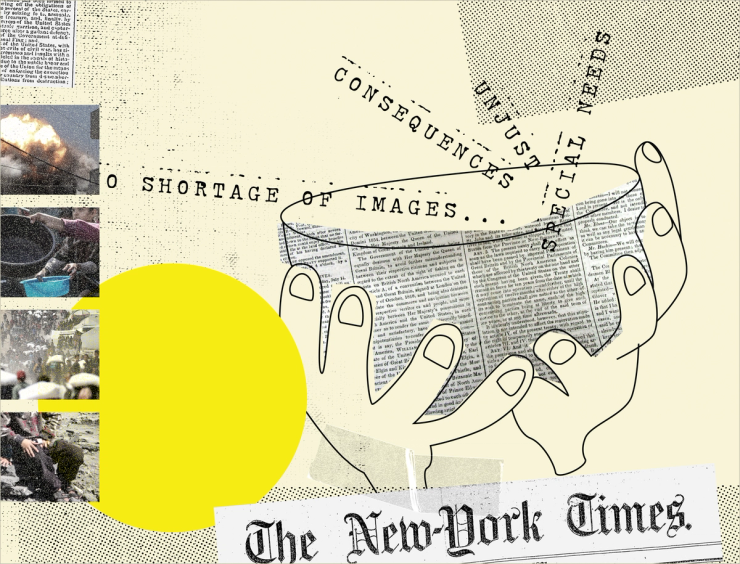The Scoop
No story in the United States is scrutinized more than coverage of the war in Gaza, and nowhere is that coverage more closely watched than The New York Times, where billboards across the street have demanded the publication “Stop the anti-Israel Bias” while pro-Palestinian protesters have distributed copies of “The New York War Crimes” in the lobby.
The Times attempts to be quite careful when it comes to the words and images it uses in relation to Israel’s war in Gaza. And as the story of deepening hunger in the territory rippled through the global media, the Times thought it was being careful, too.
Last Thursday at 3 pm, the Times was preparing to run images of Youssef Matar, a young child in Gaza with cerebral palsy who was suffering from lack of nourishment, alongside its July 24 story that cited doctors in Gaza finding “an increasing number of their patients are suffering and dying — from starvation.”
But the Times’ topmost editors wanted to err on the side of caution. After viewing the gutting photo, according to communications viewed by Semafor, they worried that it might inadvertently call into question the paper’s reporting, which said that many of the children suffering from hunger did not have preexisting health issues.
“Do we want to use a photo that will be the subject of debate when there is presumably no shortage of images of children who were not malnourished before the war and currently are?” managing editor Marc Lacey said of the proposed photo, according to Slack messages obtained by Semafor.
Executive editor Joe Kahn agreed.
“The story isn’t framed around people with special needs and the lead art really should not do that, either,” he said.
They landed instead on a photo of Mohammed Zakaria al-Mutawaq, an 18-month-old child in Gaza suffering from malnutrition, whose similarly shocking photo the paper believed illustrated the story about intense malnutrition brought about by the conflict.
Know More
After the story went live, however, pro-Israeli groups and some friendly media outlets criticized the photo, pointing out that al-Mutawaq had, as the New York Post put it, “genetic and other disorders,” which the Times’ story only briefly mentioned. The Israeli Consulate General, which reportedly made a request for an update from the Times, said in a statement that it was “unfortunate that the international media repeatedly falls for Hamas propaganda. First they publish, then they verify, if at all.”
The pushback from pro-Israel voices after the story went live prompted a flurry of activity within the Times. According to one person familiar with the reporting, after the piece ran on July 24, and the paper learned that al-Mutawaq may have had additional health issues, the Times went back and spoke with the doctor, another hospital official, his mother, and looked at his medical records. The re-reporting prompted an update from the Times, and a removal of a quote from his mother saying he was “born a healthy child.”
“We have since learned new information, including from the hospital that treated him and his medical records, and have updated our story to add context about his preexisting health problems. This additional detail gives readers a greater understanding of his situation. Our reporters and photographers continue to report from Gaza bravely, sensitively, and at personal risk, so that readers can see firsthand the consequences of the war,” the Times said.
Max’s view
The Times’ caution came at a turning point in US coverage of the war in Gaza. Some of the largest Western media outlets, many of which have tried for years to cover the war through a removed lens — and have been shut out from reporting independently in the territory by the Israeli military — now appear nearly singularly focused on the widespread hunger in the war-torn zone.
In recent days, NBC News and CNN both ran stories with shocking visuals of malnourished children, along with numerous segments about the suffering of Palestinians in Gaza and Israel’s restriction of aid coming into the area. The New York Times columnist Ross Douthat shifted his stance to write of “how Israel’s war became unjust.” And center-left writer Matthew Yglesias posted that “Since the start of Donald Trump’s second term, Israel has pivoted tactics in Gaza in a direction that is provoking mass famine. These new tactics have prompted condemnation from people who had not condemned earlier tactics.” This was a shift from earlier in the war: A researcher at Syracuse found that in the first nine months of the war, CNN’s digital coverage was notably supportive of Israel. This week, a CNN producer described the situation as “absolutely catastrophic,” with “no access to food, clean water, or medical care” and “bombings [that] never stop.”
The alternative media spaces, intensely attuned to young audiences left and right who are increasingly hostile to Israel, have shifted more dramatically. Joe Rogan reportedly turned down an opportunity to have Prime Minister Benjamin Netanyahu on his podcast, while podcast host Theo Von told Vice President JD Vance in June that he believes Israel is committing genocide in Gaza. Piers Morgan, now a YouTube sensation, moved from defending Israel to brutally grilling its diplomats, writing that they’d crossed a line. The Nelk Boys, a goofy, right-leaning Canadian YouTube outfit, embarked on a kind of apology tour after their own softball interview with Netanyahu: It was a moment they would “always regret,” one of the group’s founders, Kyle Forgeard, told the Egyptian comic Bassem Youssef, whom they invited on the show to reprimand them after an enduring wave of backlash from their audience. The group should have pressed Netanyahu “100 times harder,” Forgeard said.
Even The Free Press, the most high-profile independent media outlet with a friendly attitude towards Israel, acknowledged the alarming food shortages in Gaza, referring to it in one piece as a “hunger crisis,” and acknowledging in another that many Palestinians had not eaten meals in days (which the publication blamed on Hamas, and, to a lesser degree, Israel).
This shift comes as the American public turns against the Israeli campaign, with just 32% backing the action in Gaza, a new low, according to Gallup.
And while the Times took heat over its update last week, the existence of a major New York Times story, with all its accompanying urgency, seemed to illustrate a shift in coverage away from a focus on conflict between two sides equally and towards one about the suffering of Palestinians.
Zeteo founder Mehdi Hasan said there had been a “clear tonal shift in media coverage and political reaction.” Ryan Grim, the editor of Drop Site News, a digital news outlet that has covered the war from a perspective critical of Israel, said he sensed a shift from the legacy and broadcast outlets that had often made painstaking attempts to weigh both the Israeli and Palestinian sides with equal measure.
“I think for the normal media they see that we are witnessing a crime of historic proportions and are beginning to ask how they will look in retrospect,” Grim said.
Room for Disagreement
The Free Press commentator Eli Lake rejected the idea that the mainstream media’s tone had meaningfully shifted in favor of the Palestinian cause recently. He pointed Semafor to a previous internal uproar within The New York Times over stories about rape on October 7, and what he argued were erroneous stories about famine in Gaza (which The Free Press, in a separate piece, referred to as part of a “constant barrage of libel”), to say they merely show that mainstream news outlets have been on the side of the Palestinians for years.
“The tone has been that way for a year and a half, to put it conservatively,” he said.
The View From Times Square
One thing that pro-Israel critics of the Times and some staff at the paper agree on is that there is a large contingent of staff at the paper who are opposed to the war in Gaza, and blame Israel for the crisis.
The Times is a large paper with a variety of viewpoints reflected across its editorial staff. But over the past several days, Semafor spoke with six Times journalists, many of whom expressed frustration at the paper’s statement, saying that it undermined the paper’s vital reporting on starvation in Gaza and was an unnecessary concession — that children could have various medical conditions made worse by lack of food and water.
The update represents the challenges that the Times has faced covering a war in which pro-Palestinian and pro-Israel groups have attempted to wage a battle of inches over every detail of the paper’s coverage of the war.
The feeling among leadership at the Times, according to a senior employee, is that the goal of the various pro-Palestinian and pro-Israel groups is to cow the Times into tilting its reporting one way or the other, to make it painful to report a fact that does not align with their ideology. A senior staffer told the newsletter Status that “starvation is real and happening in Gaza and the attacks over this photo and the editors’ note are just the latest instance that we have experienced where truthful, independent reporting gets weaponized by groups representing these biased perspectives. It just gets weaponized by partisans to suggest this is propaganda or bias or somehow negates the idea that starvation and suffering is happening in Gaza.”
In a statement to Semafor, a New York Times spokesperson acknowledged the intense pressure the paper is under from interest groups attempting to sway its coverage.
“As the exchange between our editors demonstrates, we are focused on accuracy and fairness and on making sure our reporting and photography reflect the human toll of this war fully and fairly,” the spokesperson said. “We will not be swayed by advocacy groups hoping to change our journalism to align with their perspectives.”
Notable
- The Israeli media has given its public a different picture of Gaza, far from the images of starvation in the international press. The Daily explored the shifting Israeli media landscape.


